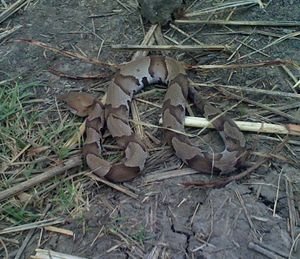Advertisement
Published: November 10th 2007

 The Site Mascot?
The Site Mascot?
This copperhead was injured, so that's why I could get so close to it. It died the next day. It was a small one, about a foot in length, and was brightly colored. Very pretty.I'm currently working on an excavation located in Garland, TX. The site is right next to the new Firewheel mall, and we are testing the area in advance of the construction for the new extension to Highway 190. Many people are surprised to know that archaeology is happening right in their own backyard. The most common question is why? What could we possibly be finding? The answer is that much of CRM work is required because of state and federal laws that say that any development on public land has to be tested to determine if any cultural resources will be destroyed in the constuction process, and to try to recover a sample of the material before it is destroyed. What we find depends very much on the region, but in general evidence of human activity exists everywhere, even though much of it is buried far below the surface.
North Central Texas is frequently referred to as a "dead zone" as far as ancient human activity is concerned. Many of the American Indians who inhabited Texas, Oklahoma, Louisiana, and Arkansas were engaged in a territorial dispute over this area. Large scale habitation was rare, and most of the evidence

 Screening
Screening
All dirt that is dug out of the unit gets sifted. The items on the orange bucket is what I pulled out of the screen. They include lithics, mussel shell, bone, baked clay, and burned rock.suggests that activity was limited to small hunting expeditions who stayed in the area for a short period of time and then returned to their respective homes. That is what we found in the previous excavations I've been on in Wylie and Blue Ridge, and it looks to be the case for the Firewheel area as well. The Firewheel site is located between two creeks that flooded regularly, so it was not possible for humans to live there permanently. The bugs and mosquitos from the creeks also made it an undesirable place to live. American Indians were just as concerned about comfort as we are today, after all!
At our site we have found evidence of small hunting parties. In one of our units, we discovered a deer skeleton with cut marks on the bone, indicating that it was butchered on the site. Next to the skeleton we found several tools, including projectile points, small knives, and scrapers. There was also a good number of flakes, where someone in the party sat and manufactered a stone tool or two. We've also found a large amount of turtle bone. Turtles were an excellent source of meat. Our PA once

 Recording a feature
Recording a feature
The group of material being photographed is a concentration of burned rock, bone, and baked clay.asked an American Indian man how turtle was cooked, and he responded "well you throw them on the fire, and if they try to crawl away you put 'em back in!"
Vandals! Our dig site is located on property where farmers still grow hay until the city buys the land to use for the highway. They have been bailing the hay for the past couple of weeks. On Tuesday, we got to the site to find that vandals had broken into the field the night before and pushed the hay bails around with a truck. They pushed six bails into the creek, and one right into one of our test pits. Just when you think you've seen it all, you wake up to find an 1800 pound hay bail in your pit! The bails are worth about $75 each, so the owner lost a good amount of money. Enough to make the crime a misdemeanor. I guess the children couldn't find any cows to tip that night.
Lab Work Since lab is one of my favorite parts of the whole process, I have been trying to get in some work at our lab for a while

 You don't see this everyday!
You don't see this everyday!
This is what we found in our unit one morning. There are apparently some bored teenagers in Garland!now. I finally got the chance this week, since the rest of the crew has the week off for Thanksgiving and there was a huge backlog of artifacts to process from our site. My job is to wash each artifact so it will be ready for analysis and curation. I sit at a sink with a toothbrush for 8 hours a day, careful washing each piece of bone, mussel shell, lithic, and burned rock that we collected. The crazy part is that I actually enjoy doing it!
Advertisement
Tot: 0.094s; Tpl: 0.012s; cc: 7; qc: 51; dbt: 0.0452s; 1; m:domysql w:travelblog (10.17.0.13); sld: 1;
; mem: 1.1mb

 The Site Mascot?
The Site Mascot?
 Screening
Screening
 Recording a feature
Recording a feature
 You don't see this everyday!
You don't see this everyday!





April
non-member comment
yay!
That's awesome that you're getting such great experience at what you love to do and doing it so close to home! :)